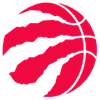Last season, I wrote a similar article covering starting pitchers with unclear roles, with the biggest hits being Bailey Ober and Braxton Garrett. I'm repeating the exercise this season. Using the RotoWire Depth Charts and recent ADP, I found six talented pitchers going late in drafts with good chances to earn a back-end rotation role. We'll look at their skills and arsenals to see if these starting pitchers should be worth our attention as potential sleepers.
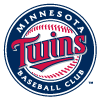 Louie Varland, Twins
Louie Varland, Twins
Varland is the hot name in the Twins starting rotation, Bailey Ober hype aside. Varland stood out earlier in the offseason due to his low ball rate last season. At 30.9 percent, he tied for sixth with Zack Littell (more on him in a minute) among pitchers with a minimum of 50 innings. That put Varland behind only George Kirby and Tarik Skubal among starting pitchers, showing the type of pitcher he could be from a control standpoint.
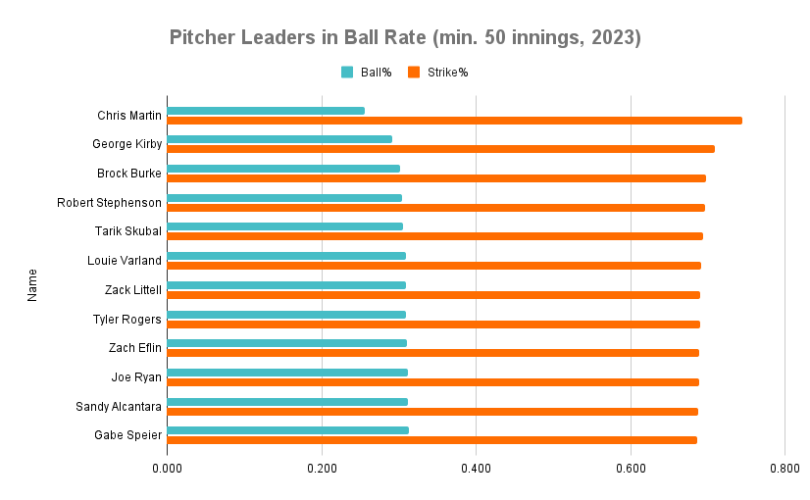
Varland made 10 starts for the Twins in the middle of the season in May and June, but the team optioned him to Triple-A after some struggles. When they recalled him as a reliever in September, he posted a 40 percent strikeout rate and a two percent walk rate. It's a small sample of 68 innings, but Varland's skills looked solid.
Varland's slider highlights his arsenal, evidenced by its 15.2 percent swinging-strike rate plus its above-average horizontal and vertical movement. Interestingly, his slider struggles against right-handed hitters, with a .327 wOBA
Last season, I wrote a similar article covering starting pitchers with unclear roles, with the biggest hits being Bailey Ober and Braxton Garrett. I'm repeating the exercise this season. Using the RotoWire Depth Charts and recent ADP, I found six talented pitchers going late in drafts with good chances to earn a back-end rotation role. We'll look at their skills and arsenals to see if these starting pitchers should be worth our attention as potential sleepers.
 Louie Varland, Twins
Louie Varland, Twins
Varland is the hot name in the Twins starting rotation, Bailey Ober hype aside. Varland stood out earlier in the offseason due to his low ball rate last season. At 30.9 percent, he tied for sixth with Zack Littell (more on him in a minute) among pitchers with a minimum of 50 innings. That put Varland behind only George Kirby and Tarik Skubal among starting pitchers, showing the type of pitcher he could be from a control standpoint.

Varland made 10 starts for the Twins in the middle of the season in May and June, but the team optioned him to Triple-A after some struggles. When they recalled him as a reliever in September, he posted a 40 percent strikeout rate and a two percent walk rate. It's a small sample of 68 innings, but Varland's skills looked solid.
Varland's slider highlights his arsenal, evidenced by its 15.2 percent swinging-strike rate plus its above-average horizontal and vertical movement. Interestingly, his slider struggles against right-handed hitters, with a .327 wOBA and .371 xwOBA, yet it performed better in 2022 (.282 wOBA, .234 xwOBA). Home runs became an issue last season with a 21 percent HR/FB rate, and the slider contributed to that, with its 23.3 percent HR/FB mark.
The other pitch to drool over is Varland's four-seamer. With his elite extension, the four-seamer jumps on hitters, and he locates and commands it well. He pounds the four-seamer in the zone 66.1 percent of the time. That's nearly 12 points above the league average zone rates for four-seamers, demonstrating Varland's control.
When the Twins acquired Anthony DeSclafani for depth, many scratched their heads at that transaction. However, with DeSclafani battling an elbow injury in Spring Training, Varland could capitalize on the opportunity to be a back-end starter. Varland's control and command give him a high floor as a starting pitcher, and he has the upside to outearn his ADP, which sits at 328 since the middle of February. As drafts inch toward 300, be sure to queue up Varland, because he may go earlier than expected.
 Reynaldo Lopez, Atlanta
Reynaldo Lopez, Atlanta
After struggling as a starting pitcher with the White Sox, Lopez transitioned to a relief role and had quite a bit of success. From 2021 to 2022, Lopez had a 3.07 ERA, 0.95 WHIP and 19.7 percent strikeout minus walk rate. Unfortunately, last season saw him move between three different teams and struggle with his control, evidenced by his 12.2 percent walk rate.
With the Braves, Lopez could earn a back-end starting pitcher role. He'll have some competition with AJ Smith-Shawver and Bryce Elder, but Lopez's stuff as a reliever could translate into a starting role. Lopez focused on throwing his four-seamer (64.3 percent) and slider (29.3 percent) most of the time over the past few seasons as a reliever. He ditched his changeup and curveball in favor of more four-seamers and sliders.
Lopez's slider has consistently been deadly and had an 18.4 percent swinging-strike rate in 2023, near his career average of 16.4 percent. Meanwhile, his four-seamer boasted a 12-13 percent swinging strike rate in 2022 and 2023 compared to a career rate of 8.7 percent. Unsurprisingly, Lopez's whiffs increased as a reliever, and his velocity jumped on multiple pitches, as seen below.

Though there's a chance Lopez's velocity decreases as a starter, his four-seamer and slider possess solid movement profiles to generate whiffs and weaker contact. His arsenal tends to play better against righties, with the four-seamer allowing a .287 wOBA and .299 xwOBA and the slider having a .272 wOBA and .294 xwOBA.
Lopez's changeup typically performed as his best pitch against lefties, with a .147 wOBA in 2023 and .077 wOBA in 2022. One would expect Lopez to throw more changeups and fewer four-seamers as a starting pitcher. His changeup had a 12.3 percent swinging-strike rate in 2023, similar to his career average of 12.9 percent.
Lopez's ADP sits outside the top-500, but he sometimes goes much earlier, including a minimum pick of 237. He seems more of a draft-and-hold target, not a 12- or 15-team mixed-league option. We have to do tons of speculating and projecting, but it's within the range of outcomes that Lopez finds success with his four-seamer and slider in 2024.
 Ryne Nelson, Diamondbacks
Ryne Nelson, Diamondbacks
The battle for the fifth spot in the Diamondbacks involves Nelson and Tommy Henry. So far this spring, Nelson beats Henry by a wide margin in both ERA (3.38 to 6.55) and K:BB (12:1 to 8:3). It's a small sample, though, so we shouldn't overreact just yet.
Last year, we waffled over Diamondbacks starting pitchers, including Nelson, Drey Jameson and Brandon Pfaadt. With recovering from Tommy John surgery and Pfaadt now firmly established in the rotation, it leaves Nelson as the remaining Arizona target late in drafts. There have been speculations about Nelson using his slider more as manager Torey Lovullo encouraged him to up the breaker usage.
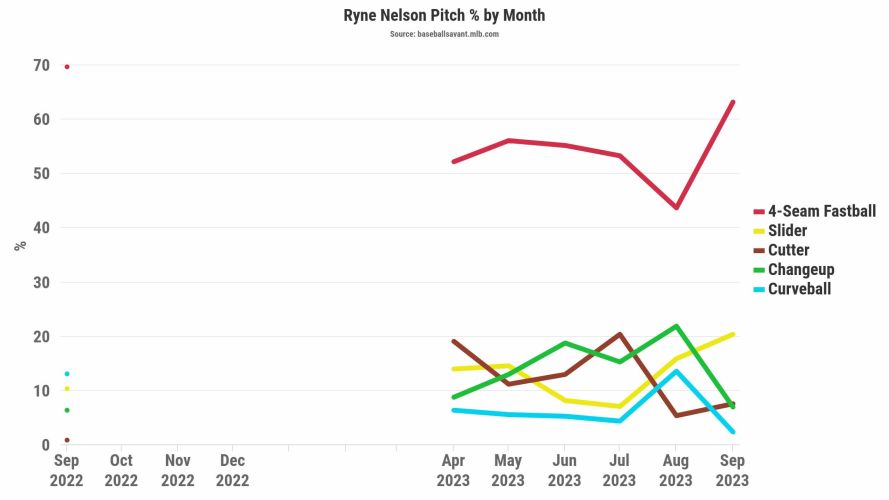
That sounds like a reasonable plan because Nelson relies heavily on his four-seamer, throwing it 54.6 percent of the time in 2023, down 15 percentage points from 2022. He traded fewer four-seamers for more cutters (14.4 percent) and changeups (13.3 percent) in 2023. BABIP regression led to much worse results on his fastball in 2023, with the BABIP against the pitch jumping from .094 to .319.
Nelson needs to improve his four-seamer, lower its usage or find another way to attack lefties and righties besides his slider. His four-seamer performed awfully against both sides of the plate, with a .385 wOBA against right-handed hitters compared to .384 wOBA versus lefties. Nelson's four-seamer also added 1.5 inches of ride. That's possibly due to him changing his horizontal release point, moving toward the third base side, as seen below.

Based on the horizontal release-point changes, one would expect slightly more arm-side run with a three-quarters release on all his pitches. Nelson also uses deception to have his four-seamer "jump" on hitters with its velocity and ride. Given the movement profile, it seems Nelson should attempt to locate it higher in the zone to be most effective.
Nelson's slider struggled to elicit whiffs last year, with a 10.9 percent swinging strike rate, down seven points from its 2022 mark. Interestingly, the results looked solid on the slider, mainly against righties, evidenced by his .201 wOBA and .196 xwOBA. Since the slider's movement profile hasn't changed much from 2022, expect its swings and misses to bounce back in 2024.
The cutter seems like a possible option to pair with the four-seamer against right-handed hitters. Nelson bumping the slider usage and locating the four-seamer up in the zone appears like a logical adjustment to be more effective in 2024. He likely won't have the strikeout upside like other late-round starting pitchers. However, there's enough there to latch onto as a deep-league streamer, given his underused slider with a movement profile that should elicit more whiffs.
 A.J. Puk, Marlins
A.J. Puk, Marlins
Puk appears set to convert back into a starting pitcher this season and has a path to a rotation spot in Miami, so maybe he doesn't fit the "murky roles" part of this article. However, questions about Puk's ability to stay healthy and handle the workload remain. He made four starts in 2021 at Triple-A with the Athletics but has only appeared as a reliever in the majors.
Puk's four-seamer (51.1 percent) and slider (42.6 percent) dominate his arsenal. His slider has evolved into more of a sweeper, which he threw two mph slower with more glove-side movement:
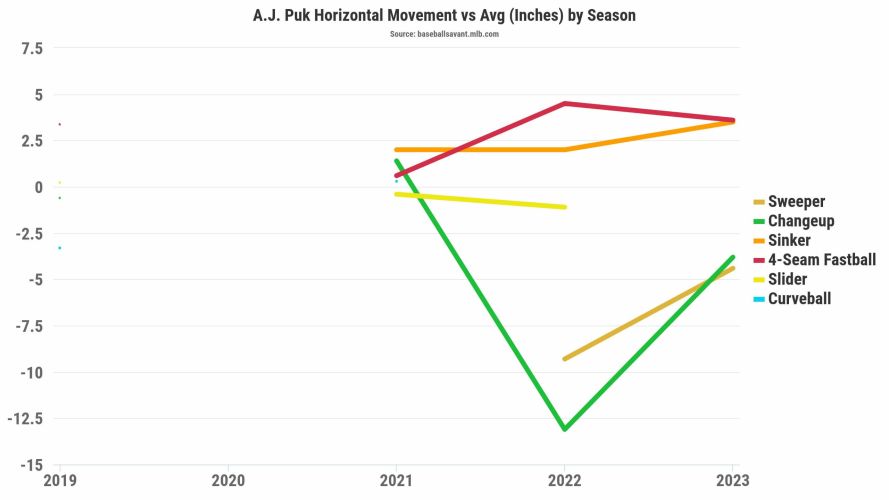
With the Marlins, Puk adjusted his sweeper/slider movement and approach, throwing it in the zone a career-low rate of 43.9 percent of the time. Though it didn't cause more chases, he threw the slider/sweeper in the shadow area of the zone 16.3 percent of the time, nearly two percentage points more than in 2022. That possibly indicates a concerted effort to locate the sweeper better, as it fared well against both righties (.248 xwOBA) and lefties (.220 xwOBA).
He mixes in a sinker 5.1 percent of the time, which generates a 72.7 percent groundball rate. Interestingly, his sinker elicited a 14.3 percent swinging strike rate, albeit in a small sample. As he transitions into a full-time starting pitcher, Puk needs a serviceable offering that fares well against opposite-handed hitters.
Puk reportedly added a changeup and cutter with the plan of being a starter. Puk used a changeup about one percent of the time over the past two seasons, and it would benefit him to use an off-speed pitch more often against right-handed hitters. The Marlins have been one of the better teams at helping pitchers develop their changeups, which is a good sign for Puk. It's worth leaning into the uncertainty and taking a chance on Puk as drafts inch toward pick 275 and beyond.
 Zack Littell, Rays
Zack Littell, Rays
After joining the Rays last season, Littell posted a 3.93 ERA while showing elite control, walking just 2.5 percent of batters faced. Littell had a league average 10.7 percent swinging strike rate, with the seventh-best ball rate at 30.9 percent. His ball rate tied with Louie Varland and Tyler Rogers among pitchers who threw at least 50 innings. With injuries in the Rays rotation to three top arms in Shane McClanahan, Drew Rasmussen and Jeffrey Springs, Littell's role is likely more solid heading into 2024.
However, the draft market seems lukewarm on Littell. He's going around pick 430 over the past two weeks, though he'll sometimes go closer to 275-300. I wrote about Littell in January when examining pitchers with interesting splitters. Admittedly, finding a control-based pitcher with a sneaky off-speed pitch draws me in. That's the case with Littell and his splitter, even if its 16.1 percent swinging strike rate is two points below the league average.
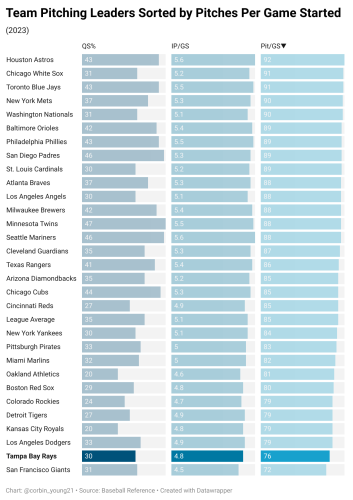
For a deeper dive on Littell, check out the article linked in the paragraph above. For now, we'll highlight the efficiency and light workloads of Rays starting pitchers. The Rays averaged the second-fewest pitches per start (76) last season, ahead of only the Giants. Littell averaged 72 per game, and he might not see that figure go up too much this season. Between his stuff, movement profiles and team context, he has some upside, and his control gives him a good floor, similar to someone like Garrett Whitlock.
 Daniel Lynch, Royals
Daniel Lynch, Royals
Injuries haven't been kind to Lynch. Shoulder troubles limited him to nine starts last season, and he battled hand issues in 2022. However, he claims he's now the healthiest he's felt in two seasons. In that same article, Lynch notes that he added 25 pounds while rehabbing to build strength, specifically in his shoulders, in hopes of preventing future injuries.
Some laugh at the narratives when a player goes to Driveline or shows up with a better physique, but we should pay attention to players making positive changes. In addition to his injuries, Lynch's control remained an issue, evident in his 37.1 percent ball rate in 2023, which aligned with his career average of 37.4 percent. That typically translates into a walk rate of around eight percent, similar to his career norm.
Lynch's stuff has been enticing in the past, mainly his changeup and slider. Those two pitches lead his arsenal in swinging-strike rate last year, with a 18.6 percent mark for his changeup and 13.3 percent for his slider. Throughout Lynch's career, his slider has a higher swinging-strike rate (17.3 percent) than his changeup (15.2 percent). It's worth noting Lynch threw his slider 1-2 mph harder last season, causing it to drop less and turning the pitch into more of a cutter. The visual below shows the movement changes on the pitch.
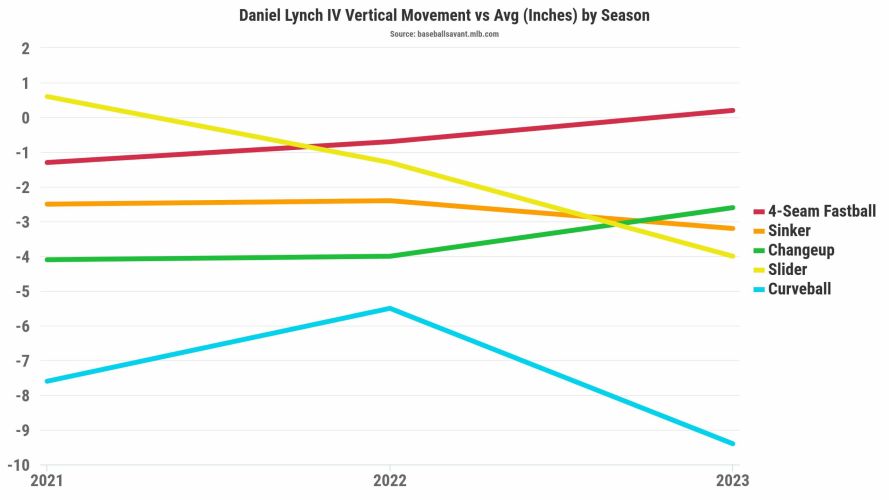
It made sense for the cutter/slider to generate fewer swings and misses since he threw it harder with less drop. Lynch used the pitch as his primary offering against lefties, throwing it 49.1 percent of the time. The pitch performed well against lefties in 2023, earning a .147 wOBA and .209 xwOBA. That may be small-sample noise, however, because his slider has allowed a .432 wOBA and .425 xwOBA over the course of his career. Let's see if Lynch's evolved slider sustains its success over more innings.
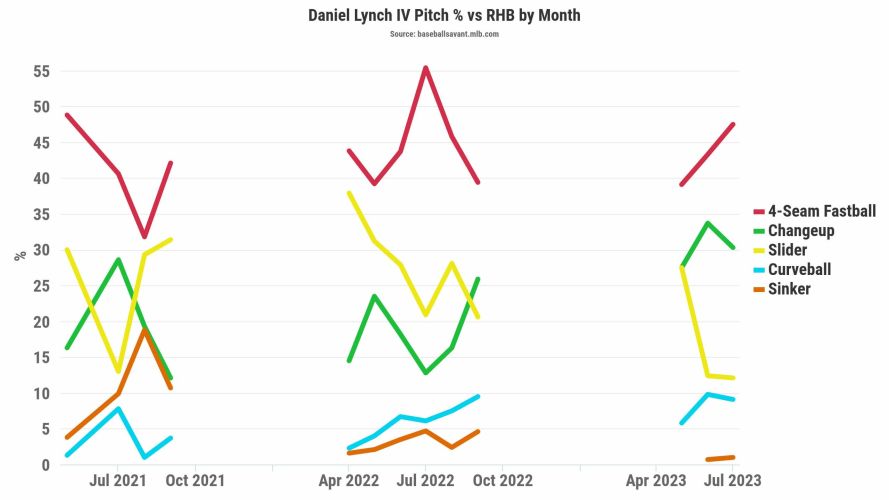
Against righties, Lynch's changeup has been effective, with a .145 wOBA in 2023. Lynch increased his changeup usage in 2023 against righties from 18-19 percent (2021-2022) to 32 percent. It seems like a purposeful decision in hopes of finding success against opposite-handed hitters, since the changeup generates both whiffs and weak contact.
It's challenging to find sleepers these days, with the fantasy baseball community being quite sharp. However, Lynch fits the mold of a post-hype sleeper with an unclear role since the Royals haven't committed to him being in the starting rotation. Lynch is most relevant in draft-and-hold leagues, with an ADP past 700. He's been taken in a wide range of spots, including a minimum pick of 330, though most of his selections occur around pick 500. Take a chance on Lynch late in drafts as a low-risk, high-reward option, given multiple pitches which generate swings and misses.








